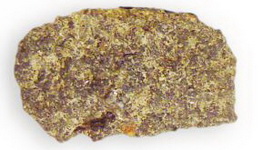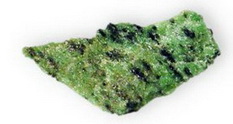Rocks
In geology, rock is a naturally occurring aggregate of minerals and/or mineraloids. The Earth's lithosphere is made of rock. In general rocks are of three types, namely, igneous, sedimentary, and metamorphic. Petrology is the scientific study of rocks.
Rock classification:
- Igneous rocks,
- Sedimentary rocks,
- Metamorphic rocks.
Ad 1. Igneous rocks

Igneous rocks (etymology from Latin ignis, fire) are rocks formed by solidification of cooled magma (molten rock), with or without crystallization, either below the surface as intrusive (plutonic) rocks or on the surface as extrusive (volcanic) rocks. This magma can be derived from partial melts of pre-existing rocks in either the Earth's mantle or crust. Typically, the melting is caused by one or more of the following processes — an increase in temperature, a decrease in pressure, or a change in composition. Over 700 types of igneous rocks have been described, most of them formed beneath the surface of the Earth's crust. These have diverse properties, depending on their composition and how they were formed.
Ad 2. Sedimentary rocks

Rock formed from sediments covers 75-80% of the Earth's land area, and includes common types such as chalk, limestone, dolomite, sandstone, conglomerate and shale.
Formation. Sedimentary-rock formation, Karnataka, India Sedimentary-rock formation, Karnataka, India Sedimentary rocks are formed because of the overburden pressure as particles of sediment are deposited out of air, ice, wind, gravity, or water flows carrying the particles in suspension. As sediment deposition builds up, the overburden (or 'lithostatic') pressure squeezes the sediment into layered solids in a process known as lithification ('rock formation') and the original connate fluids are expelled. The term diagenesis is used to describe all the chemical, physical, and biological changes, including cementation, undergone by a sediment after its initial deposition and during and after its lithification, exclusive of surface weathering. Sedimentary rocks are laid down in layers called beds or strata. That new rock layers are above older rock layers is stated in the principle of superposition.There are usually some gaps in the sequence called unconformities. These represent periods in which no new sediments were being laid down, or when earlier sedimentary layers were raised above sea level and eroded away. Sedimentary rocks contain important information about the history of Earth. They contain fossils, the preserved remains of ancient plants and animals. Coal is considered a type of sedimentary rock. The composition of sediments provides us with clues as to the original rock. Differences between successive layers indicate changes to the environment which have occurred over time. Sedimentary rocks can contain fossils because, unlike most igneous and metamorphic rocks, they form at temperatures and pressures that do not destroy fossil remnants. The sedimentary rock cover of the continents of the Earth's crust is extensive, but the total contribution of sedimentary rocks is estimated to be only 5% of the total. As such, the sedimentary sequences we see represent only a thin veneer over a crust consisting mainly of igneous and metamorphic rocks.
Classification. Sedimentary rocks are classified into three groups. These groups are clastic, chemical precipitate and biochemical or biogenic.
Ad 3. Metamorphic rocks

Metamorphic rock is the result of the transformation of a pre-existing rock type, the protolith, in a process called metamorphism, which means "change in form ".The protolith is subjected to heat and pressure (temperatures greater than 150 to 200 °C and pressures of 1500 bars[1]) causing profound physical and/or chemical change. The protolith may be sedimentary rock, igneous rock or another older metamorphic rock. Metamorphic rocks make up a large part of the Earth's crust and are classified by texture and by chemical and mineral assemblage (metamorphic facies). They may be formed simply by being deep beneath the Earth's surface, subjected to high temperatures and the great pressure of the rock layers above. They can be formed by tectonic processes such as continental collisions which cause horizontal pressure, friction and distortion. They are also formed when rock is heated up by the intrusion of hot molten rock called magma from the Earth's interior. The study of metamorphic rocks (now exposed at the Earth's surface following erosion and uplift) provides us with very valuable information about the temperatures and pressures that occur at great depths within the Earth's crust.
Some examples of metamorphic rocks are gneiss, slate, marble and schist.




